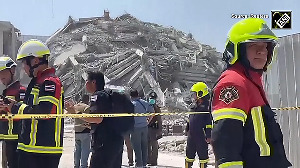Embracing the past and the present, Mexico City pulsates with warmth and vibrancy, discovers Payal Singh Mohanka.

A colourful collage of courage and passion unfolds as I walk through the Frida Kahlo Museum. It is an overwhelming experience, as one soaks in the artist's intensely creative journey scarred with pain and illness.
Yet, her resilience, her indomitable spirit and her triumph shine through.
Her famous painting of watermelons with the words Viva la Vida epitomises her mantra: Long live Life. While all else is transient, our existence, our sorrows, our joys, life will go on.
We pass on, it is only life that lives on. Kahlo completed the painting just months before her death in 1954.

Located in the Coyoacan municipality of the city, this house-museum which celebrates its 65th anniversary this year, keeps alive the memory of Frida Kahlo.
It is the house where she was born in 1907 and where she grew up, lived with her husband Diego Rivera, also an artist, and the house where she breathed her last at the age of 47.
A couple of years later, her husband turned the house, Casa Azul, into a museum to keep alive memories of the talented artist who had lived a life of exemplary fortitude and resilience.

At the age of six she was diagnosed with polio, at 18 she suffered a near fatal accident which damaged her abdomen, uterus, collar bone, spinal column and right foot.
She endured 22 operations and shortly before her death her right leg had to be amputated.
As pain racked the very depths of her being, her inexorable talent surged forth creating each masterpiece.
Bedridden, she had the easel adjusted so she could paint even in a horizontal position as she lay on her bed in agony.
On the canopy of her bed, her mother had a mirror fitted to help Kahlo paint self-portraits.

It's a veritable treasure trove of artwork by Frida Kahlo and her husband along with the couple's collection of Mexican folk art, pre-Hispanic artefacts, photographs and memorabilia.
Her search for clothes that would conceal evidence of plaster corsets owing to the physical trauma inspired her to design her iconic wardrobe. Some of her sartorial creations are also on display.
Her courageous spirit blazes within the walls of this home-museum.

The words that define Kahlo encapsulate the essence of Mexico City as it celebrates life.



The bustle of tourists admiring the full-scale replica of Michelangelo's David as it stands surrounded by sparkling fountains, the lush greenery of Chapultepec Park, the imposing Palace of Fine Arts which is the grandest performance space in the city, the unique aesthetics of the House of Blue Tiles, colourful graffiti on walls, sidewalks and cafes dressed up in the celebratory charm of marigolds.

High-voltage drama is the way to describe a visit to Handshake Speakeasy, ranked 3rd in the world's 50 best bars.
Ushered into stylish, dimly-lit interiors through a secret door in groups to the robust welcome chant of Bienvenido and a warm Hasta luego, see you later when we leave.

As we drive through downtown Mexico City we see the 545-feet high Torre Latinoamericana, the world's first major skyscraper successfully built in a highly active seismic zone.

True to Latin America's diverse culture and tradition, Mexico City is known for its warmth, hospitality and excellent cuisine.
Latin American culture is an amalgamation of European, indigenous and African influences.
As a resident, Maria Guadalupe García Gomar says, "Mexicans are known for their warm and welcoming nature. We have strong family and community feelings. We have a strong sense of solidarity during crisis. We have great cultural diversity which is reflected in our Mexican cuisine."
This Spanish-speaking country is rooted in its traditions and families celebrate the Day of the Dead (Dia De Los Muertos) to pay their respects to departed ancestors.
This two-day holiday celebrates life and death. Mexicans believe the souls of their loved one join the celebrations.

Eager to explore interesting nooks and crannies of this enchanting city, we stroll through Casa Gilardi, the last home designed by the legendary Pritzker Prize winning Mexican architect Luis Barragan, a wizard who played with light and colour and created evocative spaces.
Built between 1975 and 1977, it was Barragan's last work. He was coaxed out of his retirement by two partners in an advertising firm, Francisco Gilardi and Martin Luque.

Inspired by a large jacaranda tree, Barragan decided to take up the project to design what is today known as Casa Gilardi. After Gilardi's death, Luque was the owner of the house and named it after his partner.
The property is now owned by Luque's family and they open it to visitors for tours booked in advance. The play of light and shadow on brightly coloured walls is a visual treat.

It's a city where the modern and the ancient coalesce seamlessly.
A reminder of the past is Templo Mayor, a stepped temple that was the most revered monument in the ancient Aztec city of Tenochtitlan (known today as Mexico City) before the Spanish Conquest.
Destroyed by the Spanish in 1521, it was discovered by sheer chance in 1978. The excavation of the site is still going on.

A stone's throw away stands the Metropolitan Cathedral in all its grandeur. Built over two and a half centuries, it is an amalgamation of three architectural styles : Renaissance, Baroque and Neo-classical.

It is a journey back in time as we drive 40 kms north-east of the capital in the Mexican Highlands. Steeped in history, it is the most visited archaeological site in the country.
A UNESCO World Heritage Site, it is home to three pyramids : the Pyramid of the Sun, the Pyramid of the Moon and the Temple of the Feathered Serpent.
The Pyramid of the Sun is 230 feet tall and one of the largest pyramids in the world. The towering pyramids evoke the magnificence of a bygone era.

Fortified with a mesmerising blend of history, art and unique experiences, we bid adios to a magical city. As our cab manouvres its way towards Benito Juarez International Airport an old favourite plays on...
Chiquitita, you and I know
How the heartaches come and they go
And the scars they are leaving.
You'll be dancing once again
And the pain will end
You will have no time for grieving...
Truly Mexico City throbs with life: An ode to celebration. In the words of Frida Kahlo, Viva La Vida, Long Live Life!
Feature Presentation: Ashish Narsale/Rediff.com











 © 2025
© 2025